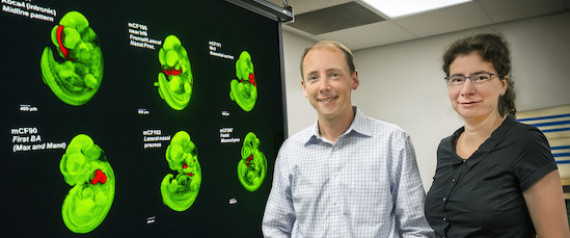
Unique face. Image taken from India Times.
Every human has a unique face and our genetics play a major role in determining the shape of our face. But we all have the same genes that control the development of our heads. How do these genes get turned on and off? However, until now scientists have not known exactly how DNA achieves this task.
A new study has found that “junk DNA” may be responsible for unique appearances. Junk DNA or non-coding DNA is the part of the genome that does not encode for proteins. The work was published on October 25, 2013 on Science.

Axel Visel and Catia Attanasio have found around 4,000 enhancers in the human genome. Picture taken from Huff Post Science.
The researchers have found over 4,000 enhancers in the mouse genome that influence the way facial features develop. According to Axel Visel, a geneticist at Lawrence Berkeley National Laboratory, “Enhancers are part of the 98 per cent of the human genome that is non-coding DNA – long thought of as junk DNA”. He also added, ” The expressions of these genes makes all the difference and all the countless variation all around us.”

Growth of experiment mice. Image retrieved from Live Science
How did they test whether enhancers were responsible for shaping our face? Visel’s team deleted three of the enhancers in mice and compared them with an unmodified mice at 8 weeks of age. The results of this experiment showed that the deletion of each enhancer caused subtle changes in the shape of the face.
Earlier, enhancers had no directly visible role of shaping an organism, but now we know that these genetic sequence can add a layer of complexity.
This research could help us understand how things can go wrong as embryos develop in the womb. However, Professor Visel said it was very unlikely in the near future that DNA could be used to predict someone’s exact appearance.
References:
‘Junk’ DNA could determine face shape, scientists say, New Research Finds How Genes Shape Faces, Fine Tuning of Craniofacial Morphology by Distant-Acting Enhancers
– Amna Awan

